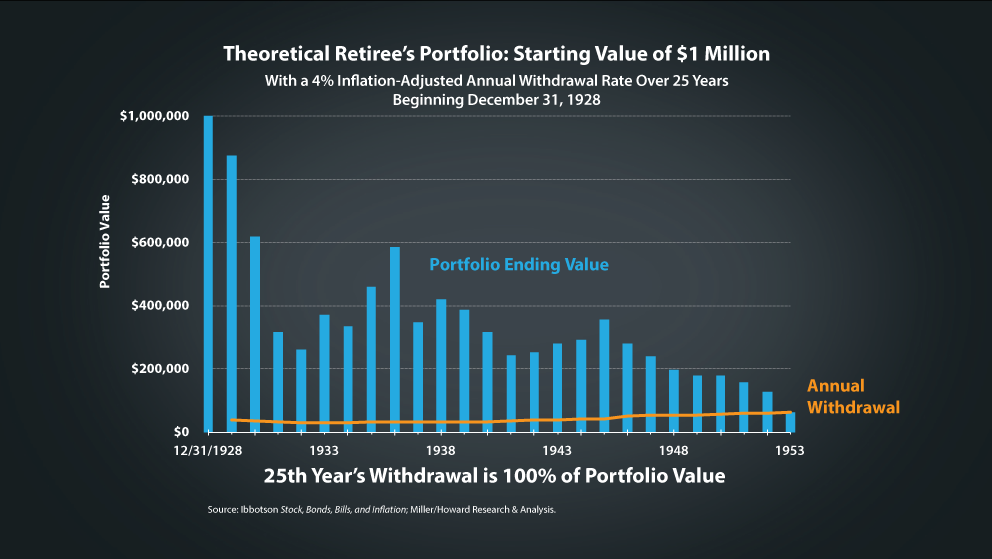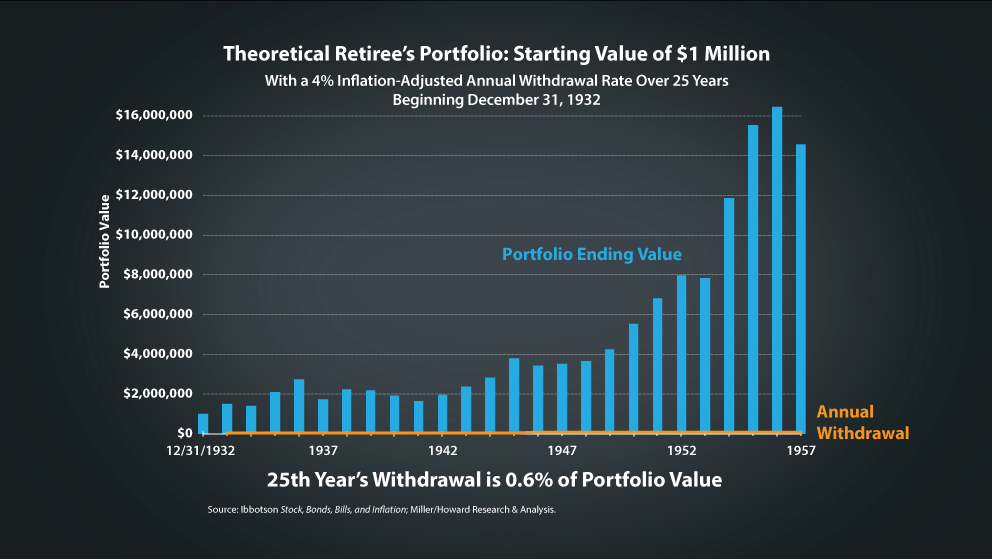Hi, I'm Jack Leslie, portfolio manager at Miller/Howard Investments. In this video I'm going to talk about dividends for spenders. Conventional wisdom suggests that retirees can "spend from total return." In other words, they shouldn't worry about whether returns are coming from principal appreciation or income—they can just sell whatever they need to raise the cash for their spending needs. This is usually accompanied by the 4% Rule, which says they can spend 4% of their starting portfolio, adjusted for inflation, each year. Besides, so the wisdom goes, the stock market has gone up on average about 10% annually in recent years, and they are only spending 4% per year, so they can do this forever, right? What could possibly go wrong? Well, not so fast.
What worries me about this logic is that it talks about percentages, while people need to spend actual money. They aren't the same thing at all. If an investor needs to sell principal to meet spending needs when the stock market is down, that principal won't be there to earn the market return during the rebound. Think about an example of a $100 portfolio. If the market falls 10%, not an especially unusual occurrence, and then they need to sell 4% of the original portfolio value for spending needs, that leaves $86. If the next year the market gains 11% to basically go back to where it started, the portfolio is now only back to roughly $95.50. The investor only got to spend $4—and they haven't raised money for this year's spending. That "missing" 50 cents is the cost of having to sell when the stock market is down, a sort of negative compounding.
How well this rule works is very dependent on when you retire. Using Dr. Roger Ibbotson's long-term stock market returns, I constructed a model to see how well this rule would have worked over a 25-year retirement, starting at various points of time. I assumed a $1 million starting portfolio, and the actual Large Company Stock returns as Ibbotson calculated them. For the withdrawal rate, I used 4% of the original portfolio value adjusted annually using the most widely quoted US inflation measure, the US government's Consumer Price Index for All Urban Consumers.

Since Ibbotsons's data series starts in 1926, I couldn't help myself from first looking at what turned out to be the worst case scenario: retiring at the beginning of 1929. By the end of 25 years, that retiree had not quite one year's worth of spending left in their portfolio before they would have run completely out of money.

Now, if that retiree had, instead, retired just four years later in 1933, the outcome would have been completely different. Then, at the end of 25 years, the retiree's next withdrawal amount would have been just 6/10ths of 1% of their portfolio rather than the 100% for the 1929 retiree. That four-year delay in retirement date meant the difference between ending 25 years later with $62 thousand or over $14 million—between outliving their money or leaving their heirs with a sizable inheritance.
Likewise, a 1962 retiree would have been withdrawing less than 7% of their portfolio at the end of 25 years, while a 1966 retiree who would have been withdrawing almost 20%. A more recent example would be a 2000 retiree that would have withdrawn almost 11% of their portfolio in 2017 and would still be seven years shy of 25 years. We should also note that this simulation ignored taxes and fees completely, which in real life could take a big bite out of the retiree's income or the portfolio, depending on how their savings were structured.
My point here isn't to say that we think that the next 25 years will be like those that followed 1929 or 1933, or 1962 or 1966. No one knows that. But we wanted to point out the risks inherent in spending from total return versus the peace of mind that can come out of spending out of a reliable and stable income stream.
If you have a portfolio of high-yielding dividend stocks that can maintain their dividends, or better yet grow their dividends, you can spend out of that income that your portfolio generates. Then you won't need to sell when the market is down. You won't need to erode your principal when you need it most, to earn a return to recover from a stock market decline. You won't need to worry about the market volatility because your spending needs are covered by the cash flows that your portfolio generates for you. Remember financial independence means being able to live off of your income.
Definitions
Ibbotson® Large Company Stocks Index is represented by the S&P 500 Composite Index (S&P 500) from 1957 to present, and the S&P 90 from 1926 to 1956.
The Consumer Price Index (CPI) is a measure of the average change over time in the prices paid by urban consumers for a market basket of consumer goods and services. Indexes are available for the US and various geographic areas. Average price data for select utility, automotive fuel, and food items are also available.

